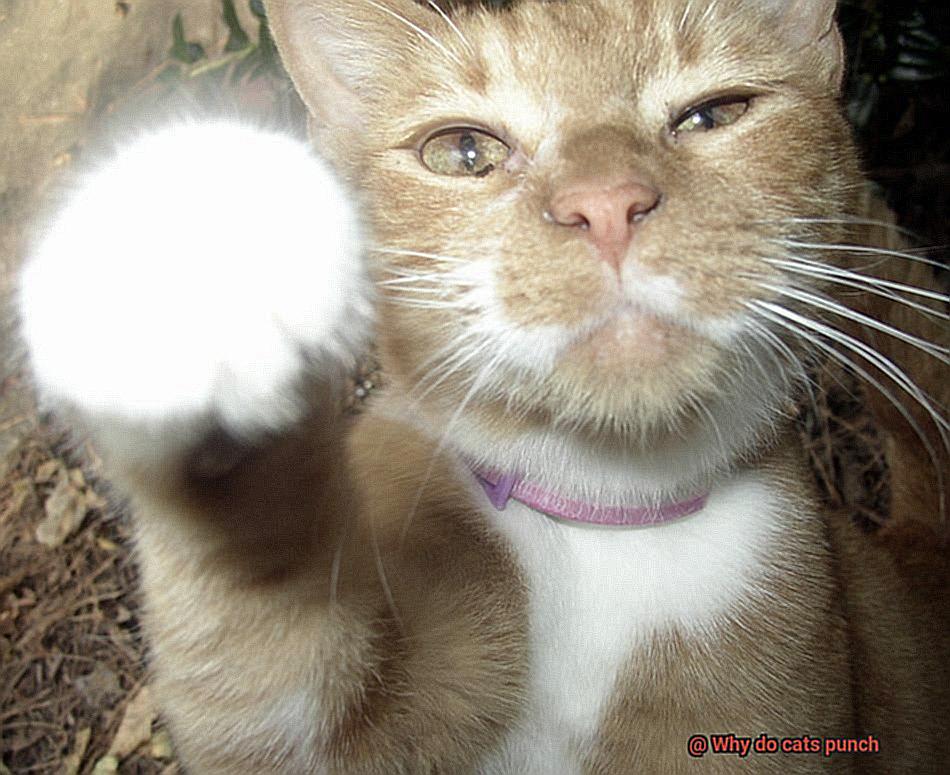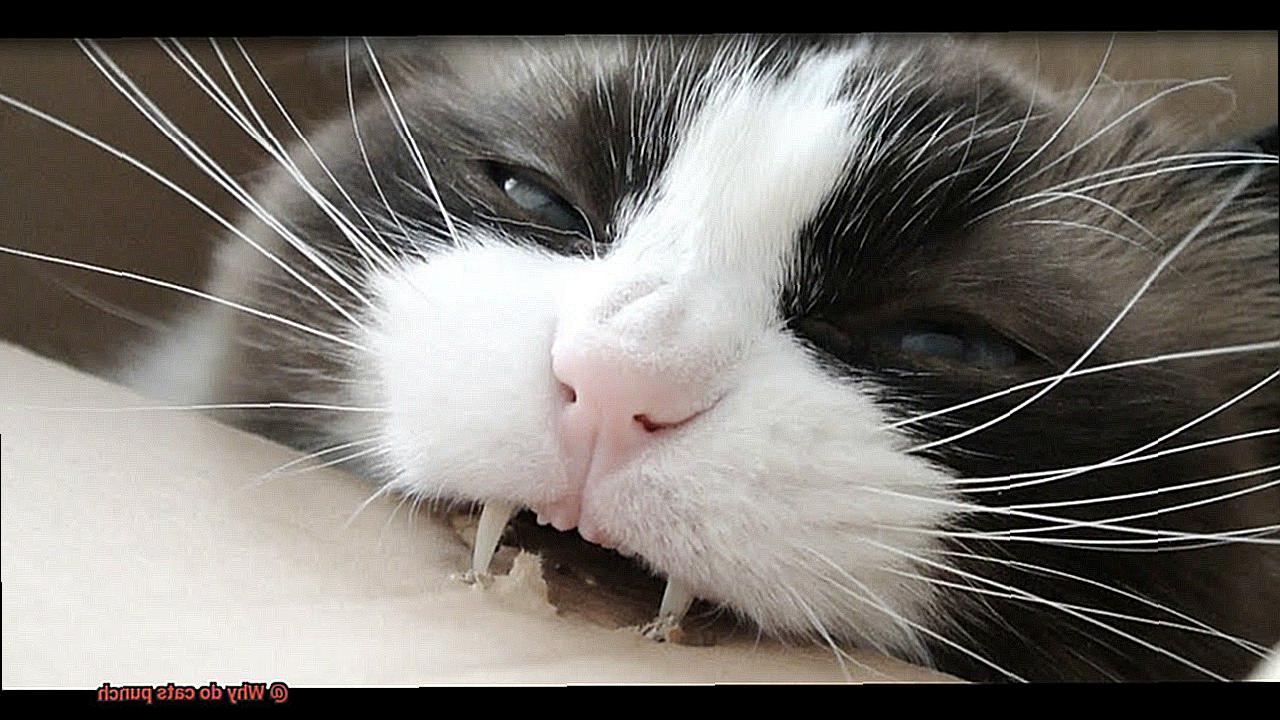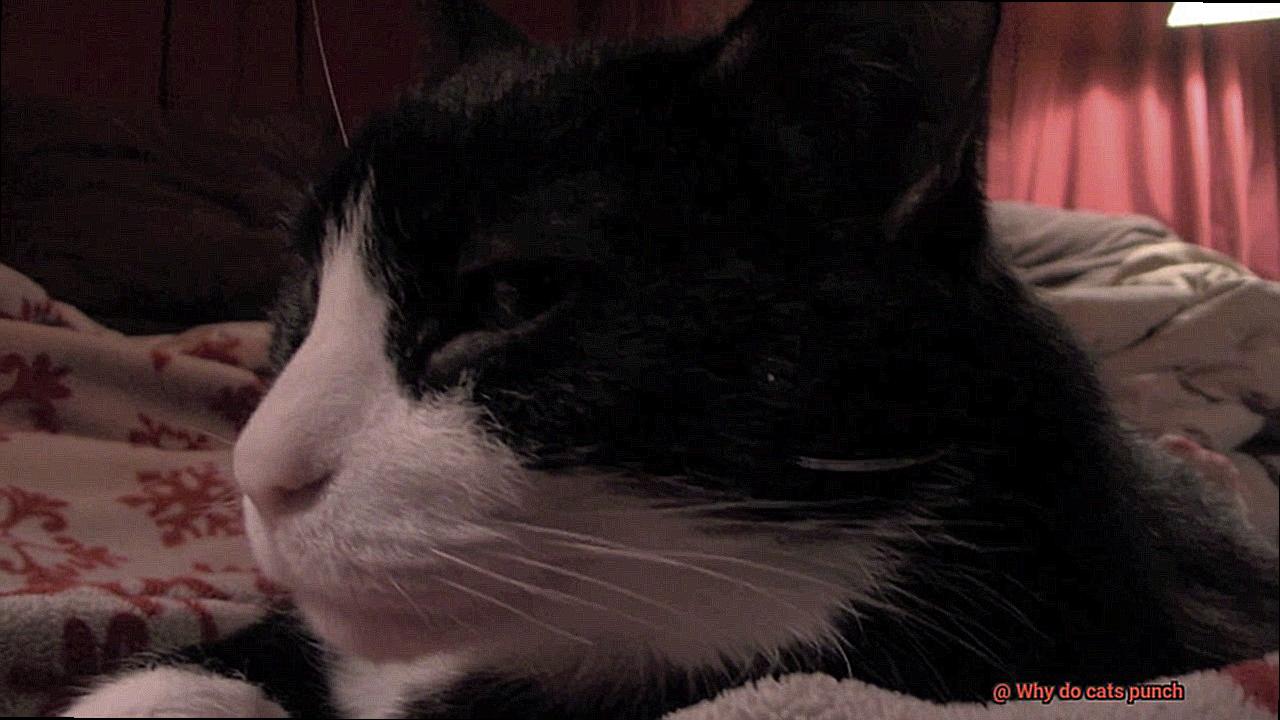Have you ever been caught off guard by your cat’s sudden punch? Or have you felt the sting of their claws as they swat at your feet? If so, you might be wondering, “Why do cats punch?” The answer to this question is not as straightforward as it may seem.
These punches, also known as “air-punching,” are a perplexing behavior that cats exhibit. At times, they can even make us feel like our beloved feline friend has turned hostile out of nowhere.
However, the truth is that cats have their own unique language, and punching is often used as a form of communication. For instance, when an adult cat hits a kitten, it is typically seen as a disciplinary measure. On the other hand, when your cat punches you, it could be a message for you to back off or retreat.
Moreover, cats may also punch to relieve stress and release pent-up energy or engage in physical play. It’s their way of stimulating themselves and having fun. You might even notice your cat batting playfully at objects or pretending to stalk imaginary prey.
Whether your cat is punching out of discipline, stress-relief or playfulness, it’s crucial to understand their behavior and communicate with them effectively. So next time your furry friend decides to throw a punch, remember that it may not be something to worry about after all.
What is Punching in Cats?

This behavior is known as punching in cats and is completely natural. Let’s explore the reasons behind this behavior and why it’s important for pet owners to understand it.
During playtime, cats punch at toys, string, or other objects to mimic their hunting instincts. This behavior helps them practice their predatory skills and keeps them mentally stimulated. But punching isn’t just for playtime. Cats may also punch to assert dominance when two cats meet. Establishing social hierarchy prevents future conflicts and helps cats coexist peacefully.
However, punching can also be a sign of aggression if a cat feels threatened or provoked. It’s crucial for pet owners to understand the underlying cause of this behavior and take steps to address it appropriately.
As pet owners, it’s essential to provide appropriate outlets for our cats to express themselves safely and without harm. If your cat is frequently punching or showing aggressive behavior, consulting with a veterinarian or cat behaviorist can help determine the root cause and find solutions to address the behavior.
Remember, punching is a natural behavior in cats that serves various purposes such as play, dominance assertion, and even aggression.

Reasons Why Cats Punch
One such behavior that can be concerning for cat owners is punching. But don’t worry. In this blog post, we’ll explore the reasons why cats punch and how owners can address this behavior.
Playfulness and Communication
Cats may punch as a way of play or communication. It’s a common behavior in kittens during play fighting with their littermates, which may carry over into adulthood. Punching can be a way for cats to establish boundaries and communicate with other cats or even their human caretakers. This type of behavior is generally harmless and should not be a cause for concern.
Self-Defense
If a cat feels threatened or cornered, they may lash out with their paws in an attempt to protect themselves. This is especially true for outdoor cats who may encounter other animals or humans who pose a threat. In such situations, punching is a natural response to protect themselves from harm.
Redirected Aggression
Cats may also punch as a result of redirected aggression. This occurs when a cat becomes agitated by something but cannot direct their aggression towards the source. Instead, they may lash out at whoever is nearby, including their human caretaker. Redirected aggression can be dangerous if not addressed promptly.

Underlying Health Issues or Pain
Sometimes, cats may punch due to underlying health issues or pain. Cats who are experiencing discomfort or pain may become irritable and more likely to lash out physically. If you suspect that your cat’s punching behavior might be due to pain or illness, consult with your veterinarian as soon as possible.
How to Address Punching Behavior in Cats
Understanding the reasons why cats punch is crucial in addressing this behavior effectively. Owners should observe their cat’s behavior closely and try to identify any triggers that may lead to punching. Providing appropriate toys and playtime can help redirect the cat’s energy and reduce the likelihood of punching behavior.
In some cases, professional help may be necessary to address the behavior effectively. A veterinarian or animal behaviorist can work with the owner to identify the cause of the punching behavior and develop a plan to address it. With proper intervention, most cats can learn to redirect their behavior and become more relaxed and less aggressive.
Signs of Stress or Fear in Cats
These could be signs of stress or fear in cats. As pet owners, it’s important to understand these signs and take steps to address them.
Aggression in cats often stems from fear or stress, rather than a desire to intentionally harm their owners or other animals. Recognizing the signs of stress and fear is crucial in understanding why cats may exhibit aggressive behaviors such as punching.
One effective way to reduce stress and fear in cats is by providing them with plenty of opportunities for play and exercise. This can help them release pent-up energy and lower their overall stress levels. Additionally, creating a safe and comfortable environment for your cat can also help reduce anxiety. Consider providing hiding spots, comfortable bedding, and plenty of toys and scratching posts to create a cozy and inviting living space.
Another important factor in reducing stress and fear in cats is to establish routine and consistency in their daily lives. This includes feeding them at the same time each day, providing a consistent sleeping environment, and maintaining a regular play schedule. By providing stability and predictability in their lives, cats are less likely to feel stressed or fearful.
It’s essential to note that any concerning behaviors or signs of aggression should never be ignored or dismissed. If you notice any concerning behaviors, it’s best to consult with a veterinarian or animal behaviorist for proper guidance.
Signs of Playful Behavior in Cats
One moment they’re lounging on your lap, and the next, they’re swatting at a toy or even at you. However, don’t be too quick to assume that your cat is being aggressive; they may just be in a playful mood. Here’s how to tell when your cat is feeling playful.
Firstly, pay attention to their body language. If your cat has a relaxed posture, an upright tail, and forward-pointing ears, then they’re likely feeling playful. You might also notice your cat crouching down slightly before pouncing on an object or person.
In addition to body language, vocalizations are another sign of playfulness in cats. They may make chirping or trilling sounds while engaging in hunting behaviors like chasing after toys or stalking prey.
Physical behaviors can also be a giveaway of playfulness in cats. They may engage in mock fighting by softly biting or pawing at another animal. Your cat may even roll onto their back and expose their belly as a playful gesture.
It’s important to remember that while these behaviors are generally harmless and indicative of play, some cats may exhibit aggressive behavior. If you’re unsure about what your cat’s behavior means, it’s always best to seek the advice of a professional animal behaviorist.

As responsible pet owners, we can help reduce our cats’ anxiety by providing them with ample opportunities for play and exercise. Creating a safe and comfortable environment and establishing routine and consistency in their daily lives will also go a long way in ensuring their well-being.

How to Communicate With Your Cat
But with a little bit of effort and understanding, you can learn to read your cat’s body language and vocalizations to build a strong bond with them.
Decode their Body Language

Cats use body language to convey their emotions and intentions. A relaxed cat will hold its tail up high and twitch the tip, while a scared or threatened cat will arch its back and puff up its fur to make itself appear bigger. By observing these cues, you can get a better understanding of how your cat is feeling.
Listen to their Vocalizations
Cats have a wide range of meows, purrs, hisses, and other sounds that they use to express different emotions. A low-pitched meow may indicate hunger or a desire for attention, while a high-pitched meow may signal excitement or agitation. By paying attention to the tone and pitch of your cat’s vocalizations, you can better understand what they’re trying to tell you.
Provide Physical Affection
Cats love physical affection, such as petting and cuddling. This is a great way to communicate your love and affection for your cat. However, it’s important to remember that not all cats enjoy being handled in the same way. Some cats prefer gentle strokes and scratches, while others may prefer more vigorous play.
Use Positive Reinforcement
Cats respond well to positive reinforcement, so using treats and toys can be an effective way to communicate with them. For example, you can use treats to reward good behavior or teach them new tricks. This positive reinforcement helps your cat understand what behavior you want from them.
Understand Your Cat’s Personality
Every cat is unique and has its own personality and preferences when it comes to communication. Some cats may be more vocal than others, while some may prefer physical touch over verbal communication. By observing your cat’s behavior and responding appropriately, you can build a strong bond with your furry companion and ensure that they feel understood and loved.
When to Seek Professional Help

But when playful swatting turns into aggressive punching, it’s time to seek professional help. This behavior can be a sign of fear, anxiety, or even a medical issue that requires attention.
If your cat’s aggressive behavior is due to fear or anxiety, seeking help from a professional such as a veterinarian or animal behaviorist can make all the difference. These experts can determine what’s triggering your cat’s behavior and provide solutions to manage it. Depending on the situation, this could include behavior modification techniques, environmental changes, or medication.
On the other hand, if your cat’s punching is due to pain or discomfort, it’s crucial to have them evaluated by a veterinarian. Once any underlying health issues have been identified and treated, the aggressive behavior may subside.
Lastly, if your cat’s punching behavior is causing harm to themselves or others, seeking professional help is essential. A professional can provide guidance on how to safely handle and manage the behavior. They can also determine if medication or other treatments may be necessary to keep everyone safe.
lR4FzOmWp68″ >
Conclusion
In conclusion, punching is a natural behavior for cats that serves multiple purposes, including playfulness, dominance assertion, and even aggression. As responsible pet owners, it’s important to understand these behaviors to communicate effectively with our feline friends.
Punching can be a way for cats to establish boundaries and communicate with other cats or their human caretakers. While this behavior is generally harmless, seeking professional help is necessary if it persists or causes harm.
To address punching behavior effectively, owners should observe their cat’s behavior closely and identify any triggers that may lead to punching. Providing appropriate toys and playtime can redirect the cat’s energy and reduce the likelihood of punching.
By creating a stable and comfortable environment with ample opportunities for play and exercise, we can help reduce our cats’ anxiety levels. This will not only improve their well-being but also strengthen the bond between us and our furry companions.
In summary, communication is key in building a strong relationship with your cat. By understanding their personality, using positive reinforcement, physical affection, body language, and vocalizations, we can create a harmonious living environment.







